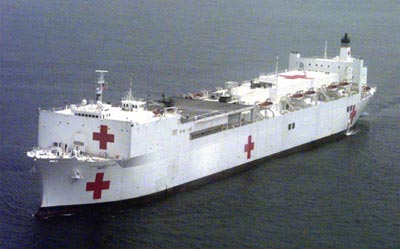Telemedicine and distance learning after the tsunamiby Taylor Dinerman
|
| The first nation to deploy telemedicine systems in response to this crisis was not the US, Australia, Japan, or a European state, but India. |
In the slightly longer term, those who are running the recovery operation have an opportunity to use telemedicine and distance learning systems. The peoples of the affected areas and, above all, the children who have been so horribly struck, can be helped by the innovative use of existing satellite communication networks. In spite of the heroic efforts of the emergency relief workers and the military men and women of all nations involved, no single force can include all the medical and public health expertise required. Not only that, but the logistics needed to support large numbers of Westerners in the devastated areas would hinder the smooth flow of food, medicine, construction materiel, and everything else that is needed to help begin the recovery process.
If there were ever a case for telemedicine being introduced, rapidly and effectively, into a humanitarian crisis situation, this is it. The first nation to deploy telemedicine systems in response to this crisis was not the US, Australia, Japan, or a European state, but India. The Indian Space Research Organization (ISRO) has brought three hospitals in the Andaman and Nicobar Islands into their ISRO telemedicine network. These are connected to medical facilities on the subcontinent, whose personnel are trained and equipped to provide specialist services.
India has a long and successful history of using both telemedicine and distance learning to support its national goals. They have not only decided to handle their emergency response themselves, without any outside help, but they have been providing significant assistance to their poorer neighbors. So far, there has not been any news of India providing telemedicine systems outside their own borders, but that may change over the next few days and weeks.
The US has also been trying to integrate telemedicine into its own various health care delivery networks. The US military, as well as Alaska and Arizona, seem to do better than the rest of America’s medical establishments. The major obstacles to its wider use revolve around cross state licensing, medical liability, and reimbursement. The Response Teams, Aircraft Carrier and Amphibious battle groups that are already in the region have various degrees of capability. The major US telemedicine systems will not reach the area until the USNS Mercy hospital ship gets into action sometime next month.
| In the longer term, military assets, such the Mercy, are not a substitute for local institutions. As the medical infrastructure in Sumatra and Sri Lanka is rebuilt, the role of telemedicine will have to be looked at. |
The 70.000-ton displacement Mercy (T-AH 19) is equipped with an older, but still very effective, “Challenge Athena” telemedicine system, capable of handling 1.54 megabits per second. The ship’s crew has a long-standing relationship with a hospital in San Diego California for Teleradiology. It is leaving port with a reduced medical team, hoping that volunteer doctors, nurses, and other experts will be found to fill in for the missing military medical people during the transit.
In the longer term, military assets, such the Mercy, are not a substitute for local institutions. As the medical infrastructure in Sumatra and Sri Lanka is rebuilt, the role of telemedicine will have to be looked at, both from the point of view of national and regional development priorities, and from that of the local medical practitioners.
One ongoing requirement will be to provide the children of these areas with post-traumatic stress counseling, reinforced by group or play therapy. The vast majority of this work can only be properly carried out by local teachers, social workers, and volunteers. Distance learning systems are the perfect way to give these people the training they will need to carry out this mission.
For Sri Lanka this will be easier than for Sumatra, since there is a considerable community of Sri Lankans living in the US and elsewhere in the West. The Sri Lankan community has been exceptionally active in organizing assistance for the people of their former homeland. They have the opportunity to organize teams of child psychologists and other experts and combine them with members of their own community, who have the language and cultural knowledge needed to make the advice relevant and effective, and to begin the training process within a few weeks.
Putting together such a project would be a task for an exceptionally creative and energetic non-governmental or charitable organization. In the aftermath of the disaster, there are probably several that could do the job, but since the hardest hit area is in Sumatra, finding Indonesians living in the US, with the required knowledge, will not be easy.
